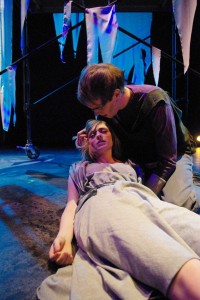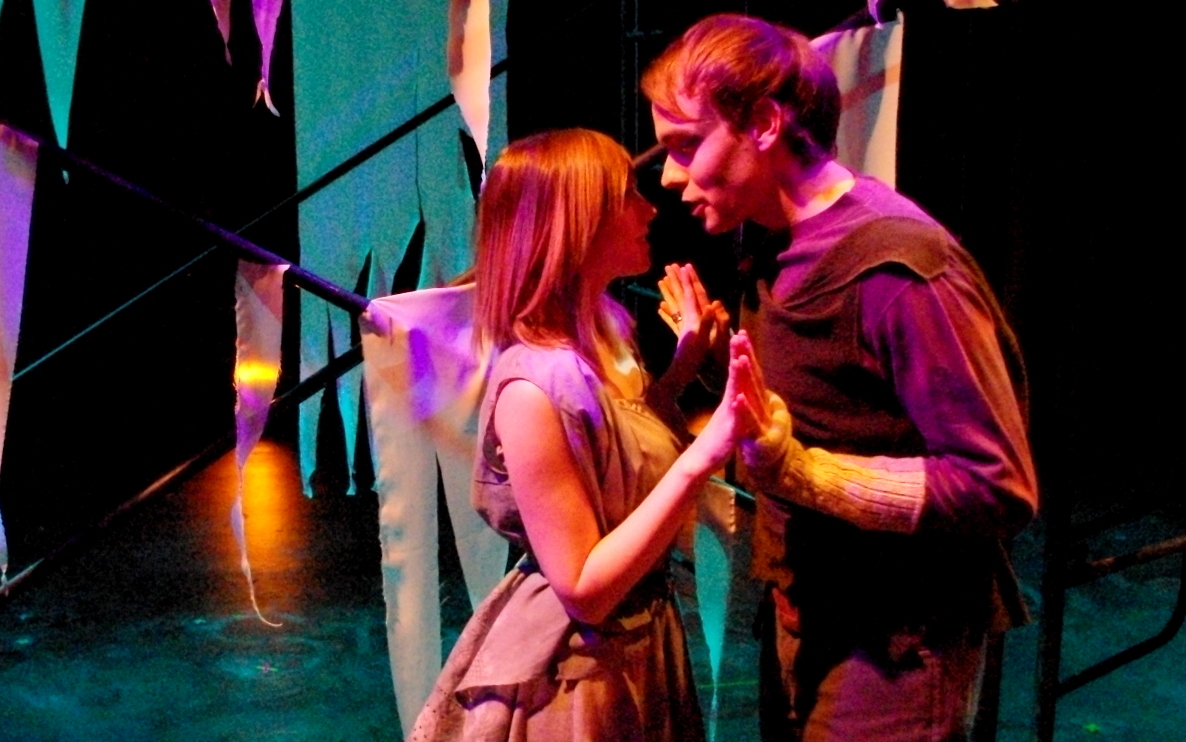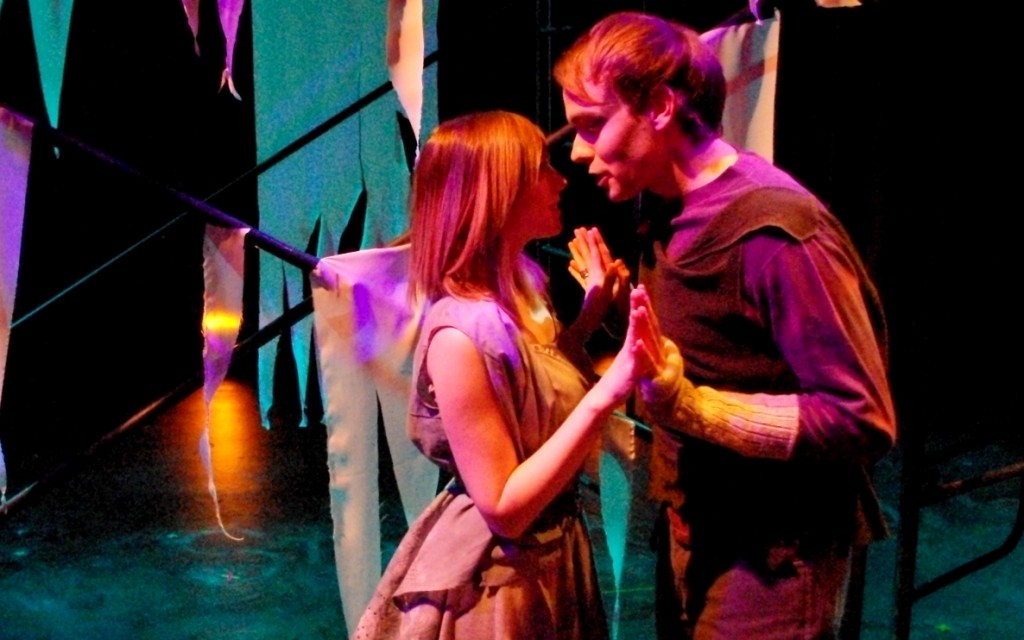Print Edition: March 5, 2014
Photos by UFV Theatre
The green room at UFV’s theatre campus is a smorgasboard of donated items, well-loved and inviting. At first it’s quiet: someone reading, someone cuddled under a blanket on the couch. But before long the room is full. People crowd into the room, introducing themselves by name, role, or responsibility. Geneva Perkins, Nurse; Melissa Harris, lighting design; Luke Stevens, Benvolio; Ron Jackson, sound design. It’s a mixture of current theatre students and alumni, siblings and spouses. In a few months they will take to the stage, but at this point they’re all just family.
“Want some Chinese food?” Stevens offers. “That’s how it works here.” He points to the plates and splits his chow mein.
Before long, we are all ushered into the studio space by stage manager Stephen Wilhite. Tables are arranged in a square and everyone begins to take their seats. I’m not expecting much out of the first read-through; it’s just a chance to get an idea of who’s whom and how the adapted script feels on the tongue.
“I don’t believe in just reading. Give it all you’ve got,” says director Paul Gélineau. He wastes no time setting the standard for the actors in the room, breaking down my expectations. As it is Gélineau’s first show with UFV, he’s finding challenges in bringing the professional world of theatre and the academic world together. He notes the obstacles posed by student schedules and urges the cast toward industry terminology, correcting “swing roles” to “ensemble cast” and “gender-bending” to “cross-casting.”
In the reading, Liam Archer asserts himself as Lord Capulet, Stevens nearly crawls across the desk as Benvolio, Eli Funk proclaims his instant, undying love for Juliet — each actor will grow far beyond this first impression, but the fabric of the characters we all know is there. It is still Romeo and Juliet.
“Romeo and Juliet and pretty much all the Shakespeares have been done in every context, and every season, and every time frame,” Gélineau says. “What I was looking at was trying to figure out a way to tell the story to make it accessible to a younger audience and to give it a contemporary sensibility.”
The show is set in an ambiguous time frame, after an unmentioned disaster decimates society. The world is rebuilding, relationships are being reconstructed, and social order is being reinvented. The word “post-apocalyptic” is used liberally, but is never overtly mentioned in the script. Actors are pushed outside their comfort zones to places that feel natural in the world they are creating.
“I never expected to be doing most of the things I’m doing in the show,” says Ashlyn Tegg of her role as Mercutio, laughing. “I’d like to think my character is very different from who I am in real life, let’s put it that way.”
The design presentation meeting is the moment of truth when actors find out how little fabric they will be wearing, and who will be keeping their hair. Tegg gets a faux-hawk, and for Dylan Schroeder’s Paris — leatherotics.
“I’m going to talk about leatherotics,” says costume designer Catrina Jackson. “I wanted to hint at why Juliet is being sent to be with Paris and we thought maybe he’s doing it as blackmail … is he wanting her as his sex slave? I don’t know.”
The design for the show has developed over the course of many months, with some starting on their ideas as early as October and spending countless hours looking for inspiration on Pinterest.
“Everything is whimsical. There’s a lot of line work in my design; the Montagues are very swooping and the Capulets are straight,” says makeup and hair designer Delaney Bergstrom.
Jackson goes on to note the basic elements of her design that distinguish between the two families.
“All the Montagues are the neutrals — greens and browns and dirt. They’re very dirty people. I kind of thought of them as the slum … Lord Montague and Lady Montague are the slum lords,” she says. “The Capulets are in control of fabric houses now; [they] have the money and power [for] new clothes.”
Then there’s the scaffolding. Romeo and Juliet is UFV Theatre at its most minimalist. This production uses only five units of scaffolding, either two or three storeys each.
And they’re on wheels.
“We spent two whole rehearsals just going over the scaffolding transitions,” says ensemble member Ally Schuurman. “My hands were raw.”
Two rehearsals is nothing compared to the week the cast spent learning how to avoid killing each other during the choreographed fight scenes. Gélineau is one of eight certified fight masters in Canada, and with his apprentices, he brings a heightened level of danger to Shakespeare’s text.
Perkins points to a scar.
[pullquote]“Their impending doom is coming. We as an audience know that, we as the artists know that; we know that this is leading to their death.”[/pullquote]
“This is from an umbrella,” she laughs. Other weapons include axes, machetes, chains, knives, tonfas, threatening garden tools, and something they call a “hook-chete.”
Noel Funk is responsible for the show’s prop design and was able to sum up his idea into one word: badass.
For the rest of the design team, the goal is to make every moment count. Harris wants the audience to notice the lights in the same way they often notice the set or costumes, something Perkins describes as unsettling.
“I feel like it’s going to be a sensory experience. There’s a lot of really interesting lighting choices that are definitely going to take people a minute — it’s very jarring.”
Jackson wants the sound to complement the set in a way that doesn’t remind us we’re watching a play.
“My goal is to create a very ambient soundscape with non-distracting music that really just melds into the play … kind of underscores everything that’s going on without distracting from the action,” he says. “I don’t want people to notice specific things as jumping up, but I want them to take the whole and say, ‘Wow, the effects in that show were great.’”
It’s one thing to design a Shakespeare show in a different setting, in a different time with an extreme amount of combat, but Gélineau took it a step further, doing a new adaptation of the script.
“Over the last 400 years people have adapted it and shortened it [or] kept some parts exactly the same,” he says. “There are so many versions and adaptations to steal from, and I’ve stolen from quite a few.”
Gélineau and the cast and crew worked for months to deconstruct Shakespeare’s star-crossed lovers, only to put them back together again in a setting more fragmented and threatening than ever before seen on a UFV stage.
“I think it’s important in an academic institution for people to understand that [Shakespeare’s] text, the scripts that we read, are blueprints,” Gélineau says. “We get creative teams, and the artists are the ones that make the building and we ornament it and colour it in a way that we think best tells that story.”
With files from Katherine Gibson.



